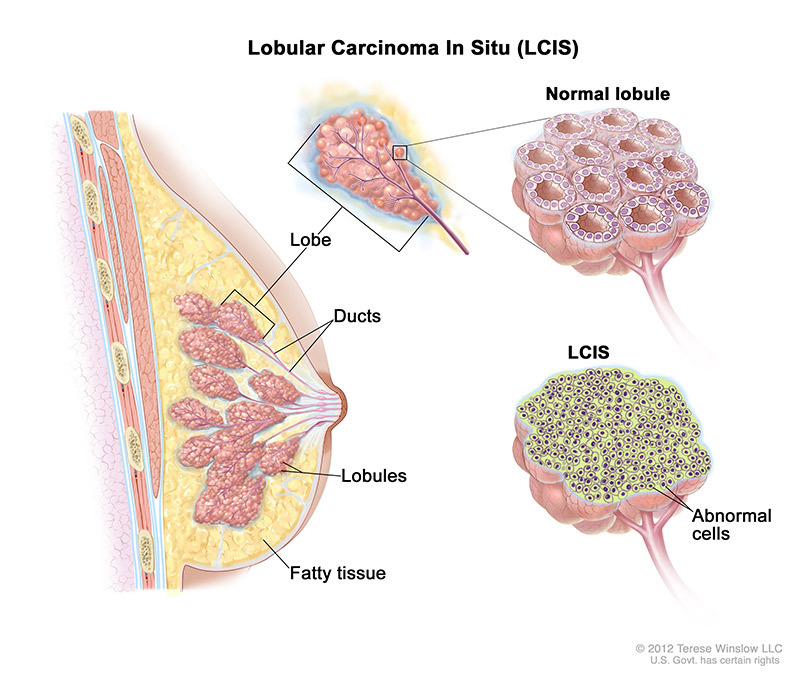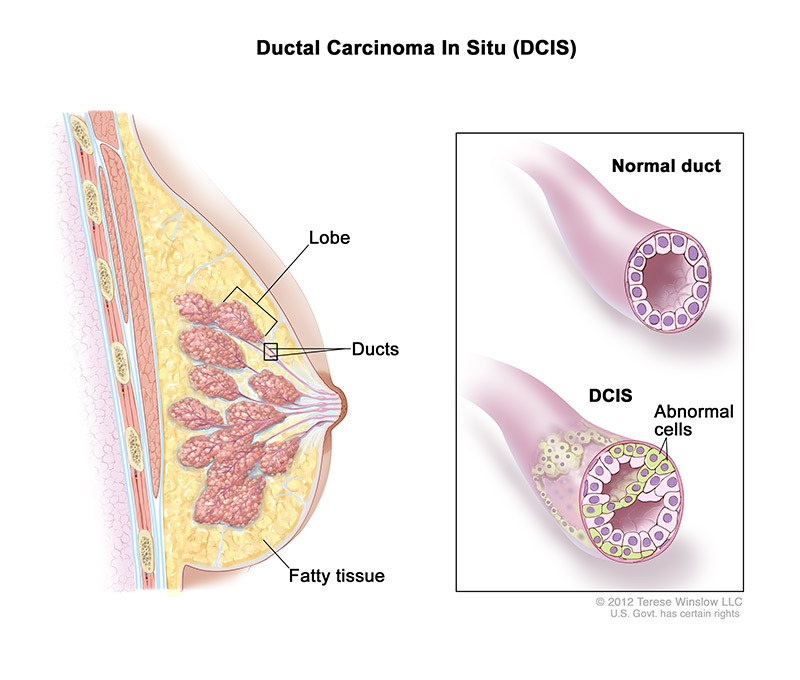Types of Breast Cancer
As part of diagnosing and staging breast cancer, your oncologist is going to establish the type of breast cancer that you have. This, along with other information such as your hormone receptor status and stage will determine the best treatment plan.
Types of Breast Cancer
Breast cancers are typically categorized as carcinomas. The tumors begin in your cells lining the tissues and organs of your body. When the carcinoma starts in the breast lobules or milk ducts that produce milk, it’s referred to as adenocarcinoma.
Along with determining where breast cancer starts within your breast (i.e milk glands or ducts), it's also classified as either noninvasive or invasive.
In situ (non-invasive) Breast Cancer
Non-invasive breast cancer cells remain in their point of origin within your breast lobules or milk ducts. They don't invade or grow into normal tissues beyond or within your breast.
1. Lobular Carcinoma in Situ (LCIS)
Sometimes called intralobular or neoplasia, this type isn't considered a pre-cancer or cancer since, without treatment, it doesn't become invasive cancer. It indicates you could possibly develop breast cancer in the future. LCIS is typically diagnosed before you experience menopause, usually between the ages of 40 and 50 years old. Less than 10% of females who received a LCIS diagnosis have already experienced menopause. It's very rare in men.

2. Ductal Carcinoma in Situ (DCIS)
DCIS is a type of noninvasive cancer. It's not life-threatening, but when you have this type of cancer, it could increase your risk of invasive breast cancer development later on. Around one in five new breast cancers will end up being DCIS. Almost all females with this early stage DCIS can be cured. Sometimes when you receive a noninvasive diagnosis, it could mean you're at a greater risk for the development of breast cancer in the future.

Infiltrating (invasive) Breast Cancer
This type of breast cancer spreads to neighboring tissues. This is the more common type of breast cancer.
1. Invasive Ductal Carcinoma (IDC)
This is the most common type of breast cancer with between 70 and 80% of breast cancer diagnoses in this category, affecting both women and men. Sometimes referred to as infiltrative ductal carcinoma, IDC irregular cancer cells that started forming in your milk ducts begin spreading into other breast tissue areas. Invasive cancer cells also have the ability to spread to other body parts.
2. Invasive Lobular Carcinoma (ILC)
This type of cancer begins in your lobules (milk-producing glands) and could potentially spread to other body parts. ILC accounts for 10% to 15% of breast cancers and is the next common type.
3. Triple Negative Breast Cancer
This is a special type of invasive breast cancer that grows faster and spreads faster than other types of breast cancer. And, because it doesn’t have receptors for estrogen or progesterone and it does not make too much HER2 protein, the best type of treatment to be used is harder to identify.
Read our blog to learn more about triple negative breast cancer and why it is harder to treat.
4. Inflammatory Breast Cancer
Another less common type of invasive breast cancer (only 1-5% of breast cancer is inflammatory), the breast looks swollen and may have the appearance of an orange peel. The breast’s inflamed look is caused by cancer cells blocking lymph vessels in the skin.
Treatment is Based in Part on the Type of Breast Cancer
The team at Cancer Care Centers of Brevard creates breast cancer treatment plans based on the type, stage and receptor status. For invasive breast cancers, patients are likely to need one or more of the following cancer treatments:
- Breast cancer surgery, such as lumpectomy or mastectomy
- Radiation therapy
- Chemotherapy
- Hormone therapy
- Immunotherapy
- Targeted therapy
More Rare Breast Cancer Types
There are other types of breast cancer that could be given based on the different irregular cell types found within your breast. These are less common and include:
1. Paget's Disease of the Nipple
This type of breast cancer is where you have cancer cells collecting around or in your nipple. Usually, the cancer impacts your nipple ducts first (these are small milk-carrying tubes) and then it spreads to the surface of your nipple and the areola (the dark skin circle around your nipple). Your areola and nipple can become:
- Red
- Scaly
- Irritated
- Itchy
It only accounts for around 1% to 3% of all breast cancer cases.
3. Medullary Carcinoma
A subtype of invasive ductal carcinoma, medullary carcinoma breast cancer that looks similar to the brain's fleshy, soft medulla, which is how it received its name. It’s not likely it will spread to your lymph nodes or grow rapidly, but it does account for 3% to 5% of all breast cancer cases.
4. Mucinous Carcinoma
Also referred to as colloid carcinoma, mucinous carcinoma is a type of invasive ductal carcinoma. With it, you have a tumor that's made up of irregular cells located in mucin pools. You find mucin in mucus, which lines your body's:
- Liver
- Digestive tract
- Lungs
- Other organs
However, in this type of cancer, mucin becomes part of the tumor, surrounding your breast cancer cells. Around 5% of invasive breast cancer cases seem to have a mucinous element in them.
5. Papillary Carcinoma
Papillary carcinoma has small, finger-like projections and typically has a well-defined border. Breast cancer doctors refer to it as micropapillary if there are very small cells. Older, postmenopausal women often receive a diagnosis of these tumors. You’ll see ductal carcinoma in situ in most invasive papillary carcinoma cases.
6. Cribriform Carcinoma
Cribriform cancer is where the cells of your breast cancer have a pattern of holes that look like Swiss cheese, according to BreastCancer.org. Working like nest-like formations, the cancer cells attack your breast’s connective tissues between your lobules and ducts. Cribriform tends to be a low-grade cancer where the cells act and appear like regular healthy breast cells. Some parts of the tumor could be considered cribriform in around 5% to 6% of invasive breast cancers.
Cancer Care Centers of Brevard Provides Leading Edge Breast Cancer Treatment
Understanding the type of breast cancer you have is just one part of the diagnosis that helps the breast cancer specialist develop the best treatment program possible. They'll also test for the presence of hormone receptors and will eventually determine the grade and stage the cancer, typically after surgery. If you are newly diagnosed with breast cancer, the oncologists at the Cancer Care Centers of Brevard will explain the type of breast cancer you have and other important information so you can discuss the best cancer treatment plan for you.